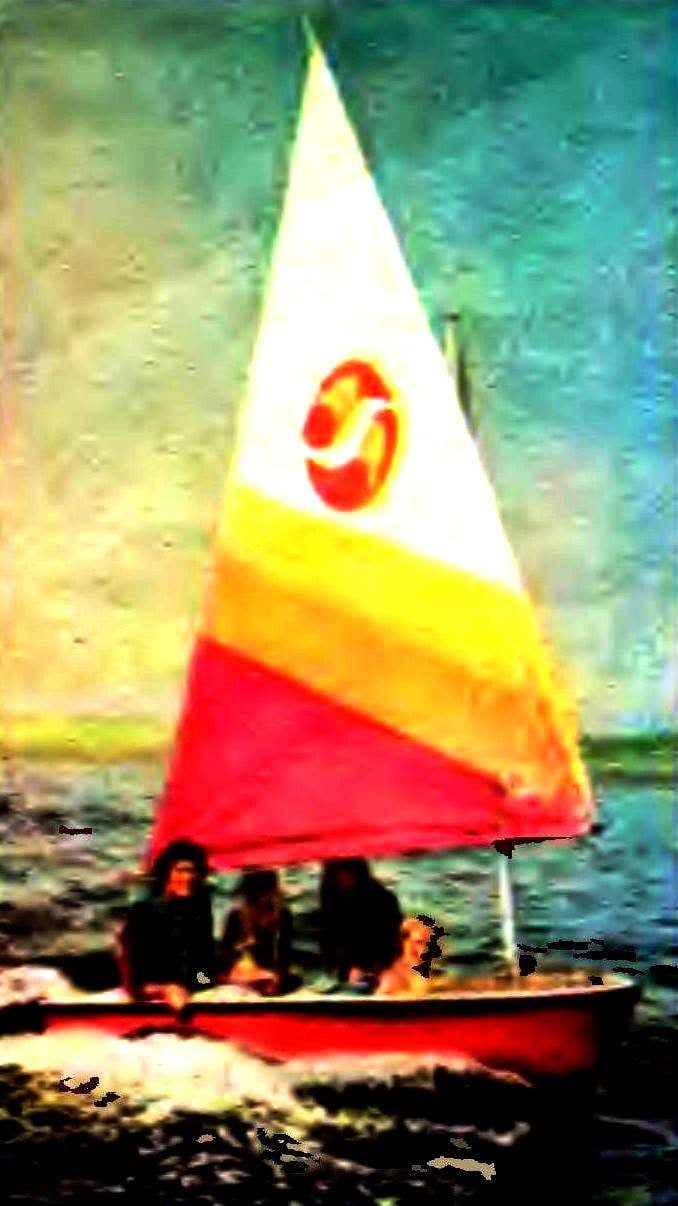 Still quite recently it seemed that forever passed away, imbued with romanticism, but proved impractical in our rationalistic age, the legendary tall ships of the past centuries — a light Brigantine, graceful schooners, swift clippers. However, forever?
Still quite recently it seemed that forever passed away, imbued with romanticism, but proved impractical in our rationalistic age, the legendary tall ships of the past centuries — a light Brigantine, graceful schooners, swift clippers. However, forever? In recent years this view has changed significantly. The confirmation of thousands of light ships that sail the lakes and reservoirs, seas and oceans. Shipbuilders are thinking about building a viable sailing giants, and while the industry has started to produce a small “family” yacht: a sailboat from the sports of the ship becomes a truly mass medium of millions.
First and foremost, the availability of sails due to the fact that shipyards have sharply reduced the cost of production of small vessels In the course went to new materials and technological methods — vyklevyvanija buildings plywood and veneer, from fiberglass on the basis of synthetic water resistant resins, the use of light alloys. Production methods of steel production one of the reasons for the emergence of the yacht monotypes, i.e. vessels with a strictly repetitive within the same class parameters.
The desire to further reduce the cost of ships led to their miniaturization. Consumers quickly appreciated the advantages of a mini-Dinghy and a yacht: they had a solid beznapornye fibreglass body, the stiffness of which is ensured only by the curvature of the shell, the inner cavity filled with foamed materials, radically critical problem of flooding, and a length of 3.5—6 m had sufficient comfort and good seakeeping.
The most popular dinghies. They can be used to participate in sailing races and leisure: tourism, walks, fishing. Today, these sailing tens of thousands. And it is widespread throughout the world, “the mirror dingy”, “Worgen” and “ILO” and serially produced in our country mini-Dinghy “Optimist” and “Cadet”.
These ships have a lot in common First of all they are cheap, easy n safe. Their length ranges from 3 to 4.5 m, width 1,2 — 1,5 m sail Area does not usually exceed 8 m2, and the weight is calculated only in tens of kilograms, which is important! — allows transporting them on krasivom the trunk of the car or, at least, a two-wheeled trailer. The small dimensions facilitate the storage and exploitation — there is no need to have permanent Parking on the water.

Fig. 1. Tourist Bermuda Dinghy with weapons:
1 — body, 2 — the centerboard, 3 — svetovy wells, 4 — Bank, 5 — guys-potens, 6 — bulkhead of the forepeak, 7 — standers, 8 — deck, 9 — shtag-potens, 10 — lanyard, 11 — guy, 12 — forestay, 13 — staysail, 14 — the grotto, 15 — mast, 16 — cap, 17 — hull 18 — staysail sheet, 19 — boom-mainsheet, 20 transom, 21 — the wheel.
Structurally, a mini-Dinghy is also very similar. In figures 1 and 3 depicts two sailing ships. The first is designed for tourism and one for short trips. Hull tourist courts were to ensure comfortable accommodation of the crew and Hiking equipment, so they are characterized by a large cockpit (cut the deck) and lockers for storage of property. Shells of pleasure and sporting Dinghy is usually fully closed deck and have only a small cockpit for the crew. Otherwise they are twins.
The problem of safe navigation on the mini-Dinghy Suite is no less acute than on the biggest courts. In this case it is solved by using the buoyancy compartments of the air boxes or blocks of foam. Equipped sailboat, even after tipping over easily lifted on an even keel. In some constructions use the second bottom, or as it’s otherwise known, self-draining cockpit. Extra bottom plate is usually located above the waterline, so after lifting the ship on an even keel the water goes from the hold through the drain holes in the transom (scuppers).
An essential part of any Dinghy (which, in General, gave its name to the sailing vessels of this class) is the centerboard. It is a metal or plywood plate that is installed under the bottom of the vessel and performs a very important job in reducing drift “in the wind” and promote the “into the wind”. Structurally, Shorty make a turning or “stabbing” the Second is easier, because svartby well for them takes up less space in the cockpit, however when getting stranded a centerboard breaks down or destroys svartby well. Therefore, tourist court decided to equip the turning chertami is in contact with an underwater obstacle so the centerboard just turns around its axis.
Steering device mini Dinghy is almost the same as that of the corresponding equipment full-sized yachts. Traditionally it consists of a tiller, balerna box and pen. Pen (in the same way as a centerboard) can be stationary and rotatable. Rumple often do with an extension cord that allows you to manage a sailboat in otkryvanii.
Sailing rig is very varied. Bermuda is widely used arms (Fig. 1), but along with him there are weapons like Guara, gateline, raked and Latin (Fig. 3, see also “M-K” № 6, 1977).
The popularity of the Bermuda weapons due to its high aerodynamic qualities. With an equal area of sails of other types (Fig. 2) Bermuda provides the ship maximum speed.


Fig. 2. The main types of weapons mini-Dinghy:
A Dinghy with weapons Bermuda (Bermuda kat); B — Dinghy with havelim weapons (Gately sloop); In the Dinghy with weapons Guara (sloop “Guara”); G — Dinghy with Latin arms; D — Dinghy with rakovin weapons (rake cat).
Weapons type Guara is somewhat different: when the same Bermuda with the height of the sail the mast is half as long as upper (flowy) the angle of the sail lifted using Hafele. This armament is very convenient for tourist vessels, as a mast with gaff and boom takes up less space during transportation.
Even lower aerodynamic qualities gateleg weapons. Despite its similarity to Guara the height of the sails is not possible to use the upper winds.
Lately with the advent of a pleasure Dinghy revived Latin service. It includes the mast, boom and long gaff, but unlike Guara height of the sail is small. An important feature of Latin sail — low centre of aerodynamic pressure (Central sail), which improves stability. It basically determined the popularity of such weapons on pleasure craft.

Fig. 3. A pleasure Dinghy with Latin weapons:
1 — grotto, 2 — jaw, 3 — mast, 4 — cockpit, 5 — boom, 6 — deck, 7 — videotronic (odores), 8 — centerboard, 9 —housing, 10 — the wheel 11 — the geek sheet.
Finally, the raked arms. It is used relatively rarely and on very small boats of the type “Optimist”. The fact that such sails low, but it pays off low centre of sail.
Standing rigging mini-Dinghy kept, as a rule, to the minimum of the forestay and a couple of guys. You can do without Standing rigging, especially when using flexible, moisture resistant wood, fiberglass or metal towers. Most of it is done on the Dinghy-catch, that is armed with one sail – the mainsail.

Swift, graceful, compact — this mini dinghies, despite the small size, comfortable and reliable.
B. Evstratov, engineer



